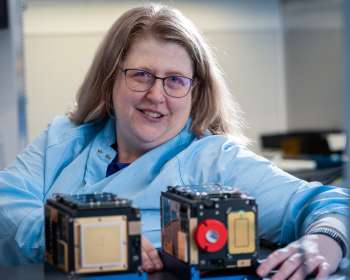Ever-shifting conditions in Earth’s ionosphere-thermosphere (I-T) system driven by energy from the sun and lower weather conditions can negatively affect numerous space and Earth-based technologies such as GPS navigation and radar tracking. To understand and forecast this region globally, scientists rely on computer models and other tools that require more and different types of data from the I-T system than is currently available.
A team of scientists at The Aerospace Corporation has been selected as part of NASA’s Geospace Dynamic Constellation (GDC) Interdisciplinary Scientist (IDS) competition to support the GDC satellite’s mission to study the Earth’s I-T system and understand how it is affected by energy from the Sun and lower atmosphere. As an added benefit, the unique global dataset collected by the GDC mission will aid in model improvements of weather conditions from the Earth’s surface to the boundary between the Earth and the Sun’s magnetic fields.

In addition to being a part of the core GDC science team assisting in a number of early mission related activities, the Aerospace team will be developing the Atmospheric Data and Mission Planning Tool in an Interactive Visualization Environment (ADAPTIVE). This tool will tackle some of the most difficult and under-prioritized aspects of a science constellation mission: the organization, utilization, and visualization of the science payloads’ data.
“Through the combination of our ADAPTIVE visualization tool and the GDC science observations, our goal is to enable the scientific and public communities to explore the GDC mission findings and further our understanding of the ionosphere-thermosphere system,” said Dr. Rebecca Bishop, Aerospace’s principal investigator for the IDS ADAPTIVE project. “We are excited to be a part of the GDC team.”
ADAPTIVE will be used to produce images and videos of various aspects of the GDC mission and science data sets. It will also provide a quick look at the data over the entire constellation at any given time or location and allow extraction of subsets of the mission observational data for further analysis and study.

In addition to ADAPTIVE, Aerospace is also supporting GDC as a co-investigator on a team led by Professor Yue Deng at the University of Texas in Arlington. The team will be using physical models and observations to assist with GDC planning, with an emphasis upon the ways space weather phenomena of different sizes impact the I-T system. Dr. Christine Gabrielse, the Aerospace research scientist on the team, will use ground-based cameras that record the aurora to help with science planning, tools and technique development, and to verify GDC data after launch.
“It is extremely exciting to be involved with the GDC mission in this early phase,” Gabrielse said. “Our team is populated by both modelers and data analysts, covering a broad range of expertise in our existing assets that will help refine mission requirements, perform calibration, validation, and verification of GDC data, and assist with producing data products as well as analysis techniques. With recent advances in our models and GDC on the horizon, it’s a thrilling time to study Earth’s ionosphere and the ways it is impacted by Space Weather.”
More information about NASA’s GDC mission is available here.

